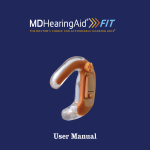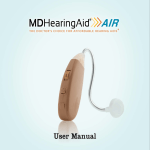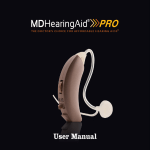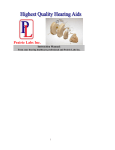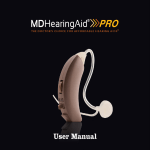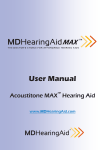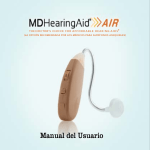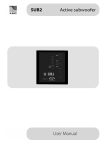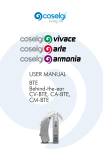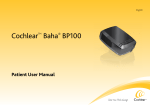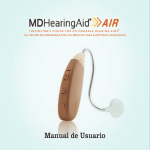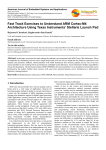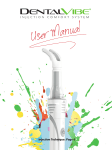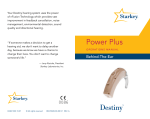Download English User Manual
Transcript
User Manual Congratulations! ® As the owner of the MDHearingAid AIR Hearing Aid, you may once again enjoy the sounds of your environment and conversations with your family and friends. In order to get the most out of your MDHearingAid AIR , please read this User Manual in its entirety. Your satisfaction with hearing aids depends on both the type and degree of your hearing loss as well as your expectations. No hearing aid can restore normal hearing, and not everyone will benefit equally. Free One-on-One Phone Consultations are available to help you get the best results from your MDHearingAid. Our Hearing Instrument Specialists are ready to provide assistance with any assembly or product performance questions. 312-219-8422 Mon.-Fri. 8:30 am - 4:30 pm (CST) [email protected] 24 hours a day, 7 days a week Table of Contents Hearing Aid Diagram . . . . . . . . 6 Battery Information Low Battery Warnings . . . . 22 Battery Tips . . . . . . . . . . . . 22 Battery Replacement . . . . . 23 Quick Start Guide . . . . . . . . . . 7 Care & Cleaning . . . . . . . . . . 24 Fitting & Assembly 1. Insert Battery . . . . . . . . . . 8 2. Attach Thin Tubing . . . . . . 9 TM 3. Attach ComfortTIP . . . . 10 4. Place Hearing Aid . . . . . . . . on Your Ear . . . . . . . . . . . 11 5. Turn Hearing Aid On . . . . 12 Troubleshooting . . . . . . . . . . . 26 The MDHearingAid Story . . . . 2 Package Contents . . . . . . . . . . 4 Using 13PLUS Tubing . . . . . . . 13 Selecting a Program . . . . . . . 14 Phone/Telecoil Program . . . . 16 Getting the Most from . . . . . . 18 Your Hearing Aid Protection Plan . . . . . . . . . . . 30 and Replacement Parts Warranty & Repair . . . . . . . . . 31 Return Policy . . . . . . . . . . . . . 32 Warnings . . . . . . . . . . . . . . . . 34 Important Notice for . . . . . . . . 36 Prospective Users Notice of Cancellation . . . . . . 38 Technical Specifications . . . . 39 The MDHearingAid® Story The MDHearingAid AIR was developed by a board-certified Ear, Nose, and Throat physician in Chicago, IL, Dr. Cherukuri. He encountered patients in his daily practice who would benefit from hearing aids, but many simply couldn’t afford the thousands of dollars needed to pay for them. As a physician, he knew the effects of untreated hearing loss: depression, social isolation, anxiety, and other symptoms consistent with Alzheimer's disease. Dr. Cherukuri set out to find a reasonable solution that could help with the most common types of hearing loss at a reasonable price. He was looking for a “one-size-fits-most” hearing aid, similar to reading glasses, that can easily be purchased at the drug store. 2 He evaluated numerous hearing aids and sound amplifiers, including those seen on television. He found almost all of these devices only amplified low frequencies (below 1000 Hz); however, the majority of hearing loss is in the higher frequencies (1000-4000 Hz), those most related to the human voice. Dr. Cherukuri worked with world-class Doctors of Audiology and Audiologists to create the MDHearingAid AIR . Built to exacting specifications, the MDHearingAid AIR includes advanced technologies such as: • Advanced feedback cancellation to reduce and eliminate "whistling" • Advanced compression technology to magnify soft sounds and dampen loud sounds • Advanced noise reduction that reduces noises embedded in speech and maximizes sound quality • Proprietary MDSound audio processing provides precise amplification of speech, so you can catch every nuance of conversation and communicate confidently. TM • A Telecoil setting for easy use with compatible telephones or looped environments found in many churches, theatres and public buildings The MDHearingAid AIR has been rigorously tested by leaders in the hearing loss field (ENT Physicians and Audiologists) who have unanimously agreed that the sound quality and output is incredibly accurate. 3 MDHearingAid AIR Package Contents* Hearing Aid (in inner box) with Thin Tubing and Open ComfortTIPTM; assembled for your convenience. Open TM ComfortTIP Allows natural sound and better air flow. ComfortTIPs are TM Left and Right Ear specific. Open Closed Closed Left Open Right þ When replacing ComfortTIP push over ridges on end of Tube until it is flush with ComfortTIPTM opening. ý þ TM 4 2B Additional Accessories (in bag) See combinations on page 13 which allow for higher volume use. Earhook 13PLUS Tubing Requires Customization; see page 13. Closed TM ComfortTIP After Assembly with Earhook, 13PLUS Tube TM and ComfortTIP for the highest volume without feedback. Size 13 Batteries Remove orange tab and wait at least one (1) minute before use. Wire Cleaning Tool Instructions page 24 Magnet Brush *Contents will vary depending on product ordered. Cleaning Tool in use 5 MDHearingAid AIR Diagram Thin Tubing Base Thin Tubing Volume Dial Hearing Aid Body (on/off switch) Program Button Battery Compartment Stabilizer Bar ComfortTIP TM 6 (Open) . Steps Five Easy Steps for Fitting and Assembling Your MDHearingAid AIR Step 1: Insert Battery Step 2: A ttach Thin Tubing to Hearing Aid Body* Step 3: A ttach ComfortTIPTM to Thin Tubing* Step 4: P lace Hearing Aid on Your Ear Step 5: Turn the MDHearingAid AIR On Battery *These Steps have been performed for your convenience. 7 Step 1 Fitting and Assembly Step 1: Insert Battery a) Remove orange adhesive tab and let stand for one (1) minute to activate the battery. Next, verify the Hearing Aid is turned off by turning the Volume Dial downward past 0 until you feel a click. b) Push the Nail Grip downward to open the Battery Compartment. With the red “+” side of Battery Compartment facing up, use the Cleaning Tool Magnet (or your fingers) to insert the Battery. a) Click Off b) Nail Grip c) Push the Battery Compartment upward to close. 8 Please note: If the Battery Compartment does not close easily, the battery may be inserted upside down. c) Positive Side Up 1 Step 2 Step 2: Attach Thin Tubing to Hearing Aid Body* a) Hold the top of the Thin Tubing Base (the triangular end), and place it on the Hearing Aid Body's threaded end. Twist the Hearing Aid Body clockwise, while gently pushing Thin Tubing Base onto threaded end of Hearing Aid Body. b) Make sure the Thin Tubing Base is aligned with the wide sides of the Hearing Aid Body when you are finished. a) b) Please note: Thin Tubing is ear specific. Red (2B) for Right ear use and Blue (2B) is for Left. Hearing Aid Body can be used for either. *The Thin Tubing has been attached for your convenience. 9 Step 3 Step 3: Attach ComfortTIP to Thin Tubing* TM a) Hold the Thin Tubing with one hand TM and the ComfortTIP with other hand. a) b) Push the ComfortTIP over ridges on end of Thin Tubing until it is flush TM with opening of the ComfortTIP . TM c) The end of the Tube should be visible TM through the opening of the ComfortTIP . b) Top *The Open ComfortTIP has been attached for your convenience. TM Bottom ý 10 If you are experiencing whistling at TM higher volumes, remove Open ComfortTIP TM and replace with Closed ComfortTIP . See page 13 for further modifications to increase the volume. c) þ 3 Step 4 Step 4: Place Hearing Aid On Your Ear a) Hold Thin Tubing at Stabilizer Bar TM junction. Insert ComfortTIP , with gentle pressure, into the ear canal. a) b) Place Hearing Aid Body behind the ear. The curve of the Tubing should rest on top of the ear comfortably (in front of eye wear). c) Tuck Stabilizer Bar in the outer bowl of the ear. It may be trimmed to suit the size of your ear. The MDHearingAid AIR in final position b) c) Stabilizer Bar 11 Step 5 Step 5: Turn the MDHearingAid AIR On The MDHearingAid AIR uses a Volume Dial with a built in on/off switch (like a radio). • To turn the Hearing Aid ON, turn the Volume Dial upward, past the click. Volume Dial • To turn the Hearing Aid OFF, turn the Volume Dial downward past 0 until you feel a click. IMPORTANT: When the Hearing Aid is turned ON, it will take a few seconds to begin amplifying sound. Please raise the volume SLOWLY to avoid a sudden blast of sound. 12 WARNING: Whistling may be heard if the Hearing Aid is turned ON but NOT positioned securely in your ear. This is normal. Once TM the ComfortTIP is properly inserted in your ear, the whistling will stop. ON OFF 5 Using High Volume 13PLUS Tube a) If you require higher volume than Initial Assembly produces, see chart below for further modifications. a) Attach ComfortTIP to 13PLUS Tube. TM b) b) Twist Earhook on Hearing Aid Body. c) Insert ComfortTIP , with 13PLUS Tube attached, into ear canal. Place Aid behind ear so Earhook rests on top of ear. Mark a line on Tube ABOVE Overlap bottom of Earhook. Cut Tube at marked line. TM d) Push cut end of 13PLUS Tube onto Earhook until it slides OVER the end of Earhook. c) Mark and Cut Here d) Volume Level Increases Initial Assembly Type of ComfortTIP Type of Tubing TM Open Closed Open Closed Thin Thin 13PLUS 13PLUS ComfortTIPsTM & Tubing Combinations, which allow for more gain/higher volume 13 Selecting a Sound Processing Program The MDHearingAid AIR has four Sound Processing Programs to address the most common hearing loss environments. Try the different programs in each environment to find which Program works best for you. • Once turned ON, the MDHearingAid AIR starts on Program 1. This is the default setting; every time the Hearing Aid is turned OFF and then ON again, it will re-set to Program 1. • To access the other Programs, press the Program Button and you will hear a number of audible beeps corresponding to the Program number: 14 1 Beep = Program 1 2 Beeps = Program 2 3 Beeps = Program 3 4 Beeps = Telephone /Telecoil Please note: The beeps may be faint depending on the volume setting and background noise. Program Button Program Best For Description Indicator 1. Normal Quiet Mode Home, watching TV, time with family. Increases sound in 1 Beep ALL frequencies. 2. Low Social Mode Social settings: group meetings, church, time with friends. Low frequencies (most background noises) up to 1000 Hz are not significantly amplified. 2 Beeps 3. High Noisy Mode Intense noise situations: parties, restaurants, traffic or large crowds. Ideal for people with high frequency hearing loss. Low frequencies up to 1500 Hz are not significantly amplified. 3 Beeps 4. Telephone/ Telecoil Use with compatible Telecoil enabled. telephones and looped The Hearing Aid environments (page16). microphone is off. 4 Beeps 15 Using the Telephone / Telecoil Program Telecoils or Audio Induction Loops, enable the direct magnetic coupling of your Hearing Aid to compatible telephones and other audio sources. Telecoils provide clear sound that is free of background noise and feedback. Telecoils enable comfortable use of the telephone without removing your Hearing Aid. To activate the Telephone/Telecoil mode (Program 4) Push the Program Button until you hear four tones. In Telecoil mode, the Hearing Aid microphone is disabled; only the sounds picked up from the Telecoil are amplified through the Hearing Aid. General Telephone Use The first time you use your Telecoil, place the telephone near the aid's microphone at the top of your ear. Slowly move the telephone along the length of the Hearing Aid. You will hear one spot where the dial tone becomes louder and more clear. This is the location of the Telecoil. You may have to increase the volume of the Hearing Aid slightly. To return to normal listening, push the Program Button until the desired program is reached. 16 Telephone Compatibility Most, but not all, landline phones are Telecoil compatible. Wireless and cellular phones rated T3 or T4 are Telecoil compatible (T4 is preferred). Check your telephone's instruction manual to find out its rating. Phones rated M3 or M4 are not Telecoil compatible but are hearing aid compatible. M3 and M4 phones will work with Programs 1-3. The speaker function on your phone also works well with your MDHearingAid Hearing Aids. Compatible Loop Systems The Telecoil Program can also help you listen in public places equipped with Telecoil compatible assisted listening systems. When the sign to the right is present, it signifies a Telecoil system is available. If your Hearing Aids do not operate when the Telecoil is ON, the loop system may not be operating or you may be in a "dead" spot. Try positioning yourself in a different part of the looped area, or return your Hearing Aids to your preferred Program 1-3 and sit as close to the speaker as possible. Universal Symbol for Telecoil HEARING LOOP INSTALLED Switch hearing aid to T-coil 17 Getting the Most from Your Hearing Aids Your satisfaction with hearing aids depends on the type and degree of your hearing loss and your expectations. No hearing aids, including those costing thousands of dollars, will restore the normal hearing of youth. However, you can maximize your return on your investment by understanding the 3 Keys to Hearing Aid Happiness: Balance: Both ears need to hear. e t Fi Happiness nc la Ba Fit: If the hearing aid does not fit properly, it will not work. Patience 18 Patience: Using hearing aids takes practice and patience. Key #1 — Patience New hearing aids can be a big adjustment. Your brain has to re-learn how to hear and listen. After many years of not hearing well, it takes time and practice to redevelop these skills. Medical studies show that your brain requires approximately 21 days to adjust to your new Hearing Aids. During this time: • You may initially notice lots of background sounds. These sounds have always been a part of your environment. In time your brain will recall how to process these sounds by prioritizing foreground over background sounds. • You may find that a quiet environment is more comfortable in the beginning of the adjustment period. • Your voice may sound too loud. This effect is very common for new hearing aid users, but most people get used to it over time. • Your voice may also sound 'plugged up' or like you’re talking in a barrel. This occlusion effect is normal. The sensation usually goes away in the first few weeks. • In noisy environments, you may find it easier to understand speech by facing the speaker. Reading lips and observing facial expressions and body language reinforce the sound communication. 19 Key #2 — Balance We are born with two ears for balance. It is best to maintain balance while treating hearing loss. If you have hearing loss in both ears, medical studies have shown that you will get far greater satisfaction and the BEST results by wearing two Hearing Aids, for the following reasons: • You will have a significantly better understanding of speech and conversation, since the brain is receiving sound from both ears. • You will find there will be less overall background noise amplification. • You will have better hearing and understanding in noisy situations. • You will have better localization of the direction of sounds. • Your listening will be more pleasing, effortless, and less frustrating. If you have hearing loss in both ears and only ordered one Hearing Aid, we strongly encourage you to use the enclosed Offer Code for a discount on a second MDHearingAid AIR . As always, you will receive a 45-Day Risk-Free trial with our money-back guarantee. 20 Key #3 — Fit Hearing aids, no matter how expensive, don't provide full benefit unless they fit your ear correctly. Without a proper fit, you won't reap the full benefit of your investment. • Our exclusive ComfortTIPs provide many of the benefits of custom ear molds without the added expense or wait time. Their anatomically inspired shape conforms comfortably to your ear canal and delivers superb sound quality. TM • Also available are an assortment of silicone Ear Domes which can be used with both Thin Tubing and 13PLUS Tubing. Should the ComfortTIPsTM not work for you, call customer service and they will send you more Domes to try. Using Hearing Aids takes practice and patience. Please take advantage of our FREE support at any time. You can reach Customer Service team at [email protected] or call 312-219-8422 for guidance. 21 Battery Information Low Battery Warnings: When the battery voltage nears the end of its life, the MDHearingAid AIR will provide an Initial Warning of three sets of double beeps. The Final Warning will be six sets of double beeps that sound like a motor boat. The hearing aid then shuts down until a fresh battery is installed using the procedure on the next page. Battery Tips: • Extend battery life by turning the Hearing Aid OFF when not in use and leaving the Battery Compartment open. • Do not use batteries that show signs of corrosion or leave exhausted batteries in the Hearing Aid. 22 Caution! Be sure to keep batteries out of reach from children and pets. If a battery is accidentally swallowed, seek medical attention immediately, or call The National Battery Hotline collect at 202-625-3333. 1) Battery Replacement Procedure: Click off Battery Type:The MDHearingAid AIR uses size 13 zinc-air batteries (orange tab). 2) 1. Turn the Hearing Aid OFF: rotate the Volume Dial downward past 0 until you feel a click. 2. Remove old battery: open Battery Compartment with screws facing up. Turn Hearing Aid over or use magnet on cleaning tool to remove battery. Screws 3) 4) 1minute 3. Remove orange tab from new battery. 4. Wait AT LEAST one (1) full minute for complete battery activation. 5) 5. Insert battery and close Battery Compartment. 6. Wait 45 seconds BEFORE turning hearing aid ON to allow the Low Battery Warning to be re-set. 6) 45 sec 23 Care and Cleaning •U se the brush on the Cleaning Tool to gently clean away wax and other debris. • Avoid physical shock to the Hearing Aid, such as dropping it on the floor. • Store your Hearing Aid in a cool dry place when not in use, with the Battery Compartment open. • If you are not going to use the Hearing Aid for a prolonged period of time, remove the battery to prevent corrosion. • Do not let the Hearing Aid get wet. Do not use hair spray or a hair dryer while wearing the Hearing Aid. Do not expose the Aid to excess moisture or heat. 24 arwax (cerumen) is the Single Greatest E Cause of Hearing Aid Failure. To keep your Hearing Aid and Tubing free from earwax: 1.) Remove the Tubing from the Hearing Aid Body. 1) 2) 2.) Run Cleaning Tool's wire end back and forth through Tubing, starting with the triangular shaped Tubing Base. 3.) Debris will be forced out through the TM ComfortTIP . Wipe excess earwax off TM ComfortTIP with Cleaning Tool's brush end. 3) 4.) Reattach the Tubing to the Hearing Aid Body. 4) 25 Troubleshooting 1. Instrument makes a whistling sound. • Whistling (feedback) occurs when amplified sound returns to the microphone and is re-amplified. Most hearing aids (even ones costing thousands of dollars) will whistle when not inserted properly in the ear canal. • Try reinserting the ComfortTIP into ear canal so it fits better. TM • Lower the volume. 26 • If you still require more volume to hear, try using a Closed TM ComfortTIP . • If whistling occurs after trying a TM Closed ComfortTIP , you might require more gain (volume) and should try using a 13PLUS Tube TM with ComfortTIPs • Clean any wax from the Tubing or Ear Dome using the Cleaning Tool. • Occasionally, whistling may occur when excess wax blocks the ear canal. In this case, the whistling will disappear when the condition is corrected. • If you are still having difficulty with your Hearing Aids please contact MDHearingAid Customer Service at customerservice@ mdhearingaid.com or call 312 - 219- 8422 for guidance. Office hours are Monday to Friday, 8:30 am to 4:30 pm (CST). Please note: When an object (hand, hood, person, chair, wall... etc.) comes close to your ear while wearing hearing aids, you may experience whistling. This is normal for all microphones, not just microphones in hearing aids, when the microphone is temporarily obstructed. 27 2. Instrument has a weak or no sound. • Make sure the Hearing Aid is ON. The Volume Dial should be set above the number one (1). • Make sure battery is fresh and is inserted correctly. • Turn Hearing Aid OFF completely. Remove Tubing from Hearing Aid Body, turn Aid ON, and turn volume to 3. If Hearing Aid whistles, the Aid is working and the Tubing needs to be cleaned or replaced. 28 • Rotate the Volume Dial (on/off switch) back and forth, in case dust or lint has collected in the controls. • Check the battery contacts for corrosion. Tube Cleaning Tips: Thread the Cleaning Tool’s wire end through Tubing 5-6 times. Then blow gently into Tubing to expel any debris and reattach Tubing to Hearing Aid Body. 3. The sound is distorted or intermittent. • If the Hearing Aid were in a humid environment or subject to sweat, moisture may clog the aid and distort sounds. Consider using a hearing aid dehumidifier overnight. • Lower the volume. • Turn Hearing Aid OFF completely. Open then close Battery Compartment, wait 45 seconds, and turn Hearing Aid back ON. • Check the battery contacts for corrosion. • Rotate the Volume Dial (on/off switch) back and forth, in case dust or lint has collected in the controls. • Check Tubing for wax or for any signs of wear. Replace if they appear stiff, bent, cracked, or frayed. Clean if clogged with wax. • Tubing should be replaced every three (3) months. • Replace battery with a fresh one. 29 Protection Plan and Replacement Parts MDHearing Product Protection Plan TM MDHearing™ Product • Offers you 100% protection from ALL types of accidental Protection damage, including damage not covered by our standard Plan 90-Day Warranty (water or pet damage, corrosion, etc.) • Coverage must be purchased within your initial warranty period. • This service contract lasts for one (1) year from the date of purchase. Tubing and ComfortTIP Replacement TM TM For OPTIMAL PERFORMANCE, Thin Tubing and ComfortTIPs should be replaced every 3 to 6 months. Regular replacement keeps your Hearing Aids sounding and feeling like new. Visit www.mdhearingaid.com/accessories to order replacement TM Thin Tubing, ComfortTIPs ,13PLUS Tubes & Earhooks, Size 13 Batteries, and your Product Protection Plans. 30 Warranty and Repair The MDHearingAid AIR is covered against defects in materials and workmanship for 90 days from the date you receive your order. If our examination determines that the unit failed to work due to parts, materials or workmanship, we will repair or replace it for free. This warranty does not cover malfunctions due to unusual wear and tear or mistreatment of the Hearing Aid, such as physical shock, damage from moisture or sweat, excessive wax build-up, or tampering with the instrument, all of which void the warranty. If you require Warranty or Repair Service, please contact Customer Service for a Return Merchandise Authorization (RMA) number, repair costs, and instructions. Repair Facility address: For fastest service e-mail: MDHearingAid, Inc. [email protected] Repairs Department 18447 W. 8 Mile Road Or, call Customer Service at: 312 - 219- 8422. Office hours: Detroit, MI 48219-1520 Monday to Friday, Do not mail to this 8:30 am to 4:30 pm (CST). address without contacting Customer Service first. 31 Return Policy Your satisfaction is guaranteed. If you are not satisfied with your MDHearingAid, you have 45 days from the date of purchase to return it for a full refund. MDHearingAid requires a minimum trial period of 21 days. This minimum trial period is required because medical studies show that your brain requires about three weeks to adjust to new hearing aids. Return requests prior to 21 days from date of invoice will incur a ten percent (10%) Early Return Fee. All products MUST include a Return Merchandise Authorization (RMA) number for proper processing. Products returned without a RMA number will incur a twenty percent (20%) No-RMA Fee. Please e-mail [email protected] for a RMA number and specific return instructions. We are available 24 hours a day, 7 days a week (a calendar day equals a business day). Or you may call Customer Service, 312-219-8422 Monday to Friday, 8:30 am to 4:30 pm Central Standard Time. 32 Days Amount Refunded from Invoice with RMA w/out RMA 1- 20 21-45 46+ 90% 100% 80% 80% No Refund No Refund We are unable to honor return requests after 45 days from the date of purchase as shown on your invoice. Return Facility address: MDHearingAid, Inc. Returns Department 18447 W. 8 Mile Road Detroit, MI 48219-1520 Please DO NOT mail to this address without contacting customer service first. 33 Warnings to Hearing Aid Dispensers A hearing aid dispenser should advise a prospective hearing aid user to consult promptly with a licensed physician (preferably an ear specialist) before dispensing a hearing aid. If the hearing aid dispenser determines through inquiry, actual observation, or review of any other available information concerning the prospective user, that the prospective user has any of the following conditions, then consult a physician. • Visible congenital or traumatic deformity of the ear. • History of active drainage from the ear within the previous 90 days. • History of sudden or rapidly progressive hearing loss within the previous 90 days. • Acute or chronic dizziness. 34 • Pain or discomfort in the ear. • Unilateral hearing loss of sudden or recent onset within the previous 90 days. • Audiometric air-bone gap equal to or greater than 15 decibels at 500 hertz (Hz), 1000 Hz, and 2000 Hz. • Visible evidence of significant cerumen accumulation or a foreign body in the ear canal. Stop Using MDHearingAid AIR and Consult a Physician if: • Hearing in one or both ears worsens. • Your ear becomes occluded with excessive ear wax. • Hearing does not improve while using the MDHearingAid AIR • You develop an infection of your ear or ear canal. • Skin irritation develops in or around your ear canal. Special care should be exercised in selecting and fitting a hearing aid whose maximum sound pressure level exceeds 132 decibels because there may be risk of impairing the remaining hearing of the hearing aid user. A hearing aid will not restore normal hearing and will not prevent or improve a hearing impairment resulting from organic conditions. In most cases infrequent use of a hearing aid does not permit a user to attain full benefit from it. The use of hearing aid(s) is only part of hearing rehabilitation and may need to be supplemented by auditory training and instruction in lip reading. 35 Important Notice for Prospective Users Good health practice requires that a person with a hearing loss have a medical evaluation by a licensed physician (preferably a physician who specializes in diseases of the ear) before purchasing a hearing aid. Licensed physicians who specialize in diseases of the ear are often referred to as otolaryngologists, otologist or otorhinolaryngologists. The purpose of a medical evaluation is to assure that all medically treatable conditions that may affect hearing are identified and treated before the hearing aid is purchased. Following the medical evaluation, the physician will give you a written statement that your hearing loss has been medically evaluated and you may be considered a candidate for a hearing aid. The physician will refer you to an audiologist or a hearing aid dispenser, as appropriate, for a hearing aid evaluation. The audiologist or hearing aid dispenser will conduct a hearing aid evaluation to assess your ability to hear with and without a hearing aid. The hearing aid evaluation will enable the audiologist or dispenser to select and fit a hearing aid suited to your individual needs. 36 If you have reservations about your ability to adapt to amplification, you should inquire about the availability of a trial/rental or purchase/option program. Many hearing aid dispensers now offer programs that permit you to wear a hearing aid for a period of time for a fee after which you may decide if you want to purchase the hearing aid. Federal law restricts the sale of hearing aids to those individuals who have obtained a medical evaluation from a licensed physician. Federal law permits a fully informed adult to sign a waiver statement declining the medical evaluation for religious or personal beliefs that preclude consultation with a physician. The exercise of such a waiver (without prior consultation by an ear specialist) is not in your best health interest, and its use is strongly discouraged. Children with hearing loss This product is not for use by anyone under 18 years of age. In addition to seeing a physician for a medical evaluation, a child with a hearing loss should be directed to an audiologist for evaluation and rehabilitation. Hearing loss may cause problems in language development, educational growth, and social growth of a child. An audiologist is qualified by training and experience to assist in the evaluation and rehabilitation of a child with a hearing loss. 37 Notice of Cancellation YOU MAY CANCEL THIS TRANSACTION, WITHOUT ANY PENALTY OR OBLIGATION, WITHIN 45 DAYS FROM THE DATE OF PURCHASE. IF YOU CANCEL, ANY PROPERTY TRADED IN, ANY PAYMENTS MADE BY YOU UNDER THE CONTRACT OR SALE LESS ANY NONREFUNDABLE RESTOCKING FEE, AND ANY NEGOTIABLE INSTRUMENT EXECUTED BY YOU WILL BE RETURNED WITHIN 10 BUSINESS DAYS FOLLOWING RECEIPT BY THE SELLER OF YOUR CANCELLATION NOTICE AND ALL MERCHANDISE PERTAINING TO THIS TRANSACTION, AND ANY SECURITY INTEREST ARISING OUT OF THE TRANSACTION WILL BE CANCELLED. IF YOU CANCEL, YOU MUST RETURN TO THE SELLER, IN SUBSTANTIALLY AS GOOD CONDITION AS WHEN RECEIVED, ANY GOODS DELIVERED TO YOU UNDER THIS CONTRACT OR SALE. TO CANCEL THIS TRANSACTION, MAIL OR DELIVER A SIGNED AND DATED COPY OF THIS CANCELLATION NOTICE OR ANY OTHER WRITTEN NOTICE, OR SEND A TELEGRAM, TO MDHEARINGAID, 917 W. WASHINGTON BLVD, SUITE 202, CHICAGO, IL 60607 NO LATER THAN MIDNIGHT OF THE 45TH DAY AFTER THE INITIAL TRANSACTION. “I HEREBY CANCEL THIS TRANSACTION,” SIGNED: 38 (Buyer’s Signature) (Date) Technical Specifications MAX OSPL90 . . . . . . . . . . . . . . . . . . . . . . . . 126 dBSPL HF Average OSPL90 . . . . . . . . . . . . . . . . . . . 119 dBSPL HFA Full-on-gain . . . . . . . . . . . . . . . . . . . . . . . 40 dBSPL THD@ . . . . . . . . . . . . . . . . . . . . . . . . . . . . . 800 Hz. 0.6% . . . . . . . . . . . . . . . . . . . . . . . . . . . . . . . . . .1600 Hz 0.7% EQUIV INPUT NOISE . . . . . . . . . . . . . . . . . . . . . . . 26 dB BATTERY CURRENT DRAIN . . . . . . . . . . . . . . . 0.90 mA 39 www.MDHearingAid.com Printed in U.S.A. 10.15











































